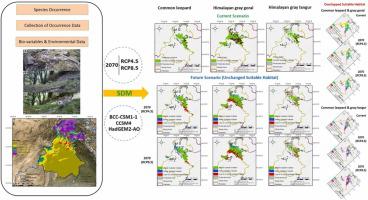Global Ecology and Conservation ( IF 3.5 ) Pub Date : 2023-03-01 , DOI: 10.1016/j.gecco.2023.e02418 Babar Zahoor , Melissa Songer , Xuehua Liu , Qiongyu Huang , Yunchuan Dai

|
Global warming due to anthropogenic activities has alarming effects on biodiversity. It could negatively impact the interactions between predators and their prey by shifting or eliminating their suitable habitats. The predator common leopard (Panthera pardus) and two prey species, Himalayan grey goral (Naemorhedus goral) and Himalayan grey langur (Semnopithecus ajax) play important roles in balancing the forest ecosystem in northern Pakistan. The common leopard is listed as a Vulnerable species on the IUCN Red List, while grey goral and grey langur are listed as Near Threatened and Endangered respectively. For this study, we used Maximum Entropy Model (MaxEnt) to model the current (average for 1950–2000) and future (in 2070) suitable habitat for each of these species using three General Circulation Models [GCMs; i.e. Beijing Climate Center Climate System Model (BCC-CSM1–1), Community Climate System Model (CCSM4), and Hadley Global Environment Model 2 (HadGEM2-AO)]. We used two climate change emission scenarios, i.e., a moderate carbon emission scenario (RCP4.5) and an extreme carbon emission scenario (RCP8.5). Our results indicated that an area of 18,360 km2, 34,142 km2 and 10,636 km2 are currently suitable for the common leopard, grey goral, and grey langur, respectively. In the future, common leopard, grey goral and grey langur were predicted to lose over 11%, 43%, and 44% of currently inhabited areas under the most severe climate scenario (RCP8.5), respectively. Overall, 56–89% of the current suitable habitat area was predicted as stable suitable habitat for all the species. The study projected that currently, 14,321 km2 is suitable for both common leopard and grey goral. Whereas, 7096 km2 of current habitat is suitable for both common leopard and grey langur. Overlapping areas were predicted to be reduced in the future (due to fluctuations in temperature and precipitation), ranging from 2% (under RCP8.5) to 8% (under RCP45) for areas suitable for common leopard and grey goral, and from 30% (under RCP4.5) to 47% (under RCP8.5) for areas suitable for common leopard and grey langur, respectively. Most of the overlapping areas that remained suitable were projected between the altitudinal range of 1000 m – 3000 m for common leopard and grey goral, and from 2000 m to 4000 m for common leopard and grey langur. Our results inform management plans and conservation strategies (e.g., establishment of new or improving the status of existing protected areas) for mitigating the impacts of climate change on endangered predator and prey species in the northern Pakistan.


















































 京公网安备 11010802027423号
京公网安备 11010802027423号